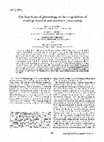Papers by Claire M Fletcher-flinn
Creativity Research Journal, 1999
thoughtful comments by Michael Corballis and Thomas Keenan on an earlier version of this manuscript.

Memory & Cognition, 1995
It has been claimed (Y. Coltheart, Laxon, Rickard, & Elton, 1988) that learners as well as skille... more It has been claimed (Y. Coltheart, Laxon, Rickard, & Elton, 1988) that learners as well as skilled readers use phonology for multiple functions in reading-far-meaning tasks. This claim was examined using lexical decision and sentence evaluation tasks. It was found in the first experiment that the type of instruction learners had received determined whether there was prelexical use of phonology in responding to items out of sentence context. Typeof instruction had no effect when the items were in context. In the second experiment, performances on a homophone sentence evaluation task and a homophone semantic decision task, which excluded sentence processing, were examined. The results suggest that phonology served the function of access to lexical meanings in addition to any function in postlexical sentence processing. The obtained relationships between relative frequencies of the presented and unpresented homophone mates and item accuracy on these tasks were inconsistent with exclusive use of "direct access" but consistent with access of lexical meanings via phonology and application of a "spelling-check" procedure when multiple homophonic meanings are activated.






Uploads
Papers by Claire M Fletcher-flinn